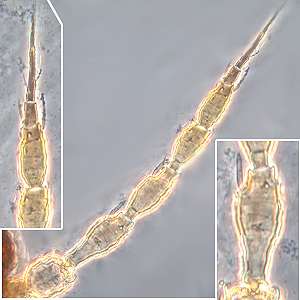Figures
Fig. 1: Antenna (insets: terminal segments VI.-VIII.
and III. antennal segment)
Fig. 2: Head dorsal with ocellar triangle
Fig. 3: Pronotum
Fig. 4: Meso- and metanotum
Fig. 5: Fore- and hindwing
Fig. 6: Tergites IV and V
Fig. 7: Sternites IV - VI
Fig. 8: Tergites VIII and IX
ITS-RFLP gel patterns (1&8 ladder, 2 PCR-product, 3 RSAI, 4 HaeIII, 5 MspI, 6 HinfI, 7 AluI)
Fig. 9: Primer pair CS249/CS250
Fig. 10: Primer pair O1/18J
Fig. 11: Primer pair 18SMP/28SMP
Taxonomic Information
Species:
Rhipiphorothrips cruentatus Hood, 1919
Synonyms:
Rhipiphorothrips karna Ramakrishna, 1928
Common name:
Grapevine thrips
Present taxonomic position:
Family: Thripidae Stephens,
1829
Subfamily: Panchaetothripinae Bagnall, 1912
Genus: Rhipiphorothrips Morgan, 1913
Species Recognition
General information about the genus Rhipiphorothrips:There are four members in this genus all have heavy reticulation with irregular reticulation on the head. The members in this group also have narrow wings and a complete division on the metanotum. Two of the species in this genus have simple sense cones on antennal segments III and IV whereas the other two species have forked sense cones. The four species are also separated by there distribution with two species known only from the Orient and the other two from Africa.
Typical character states of Rhipiphorothrips cruentatus:
Body color
Mainly brown
Antennae
Number of antennal segments: 8
Segments III & IV sensoria: emergent and simple
Terminal antennal segments: very long, needle like
Head:
Head shape between compound eyes: distinctly prolonged
Sculptured reticles on head and pronotum: with no internal markings
Surface of head, pronotum and fore legs: with strong reticulate sculpture, but sometimes irregular
Head posteriorly: constricted
Prothorax
Number of pairs of elongate pronotal setae: 0-3
Number of pairs of elongate posteroangular pronotal setae: 0
Pronotum shape: rectangular
Sculptur of pronotum: without transverse striate sculpture
Mesothorax
Mesothoracic endofurca: without median spinula
Metathorax
Metanotum: with campaniform sensilla
Metanotum major sclerite: with two major sclerites, metascutum and metascutellum
Metanotum median area: with no equiangular reticulation
Metanotum sculpture: with dominant sculptured triangle medially
Metathoracic endofurca: transverse, sometimes with simple median spinula
Wings
Wings: present and more than half as long as abdomen
First vein of forewing: close to or fused to costal vein
Forewing anterior margin: without any long setae or long cilia
Forewing color: univormly pale, with posterior margin or weakly shaded
Forewing costal setae at middle of wing: minute and scarcely extending beyond wing margin
Forewing first vein setal row: incomplete, with setae not closely and uniformly spaced
Forewing posterior margin cilia: straight, no undulations
Forewing second vein setal row: incomplete, with setae not closely and uniformly spaced
Forewing surface: not reticulate
Forewings: with veins, setae and microtrichia
Legs
Mid and hind tarsi: with one segment
Abdomen:
Abdominal segment X: never tubular, longitudinally incomplete ventrally in both sexes
Abdominal tergites: without curved wing-retaining setae
Abdominal tergites IV & V median setal pair: longer than distance between their bases
Setae on abdominal tergite X: slender
Tergite VIII posteromarginal comb of microtrichia: present laterally, incomplete medially
Tergites III to VI sculpture on lateral thirds: comprising mainly oblique reticulations
Biology
Life history:
As with other thrips species the life cycle from egg to adult is dependent on temperature. The full cycle can take about 15 days to over a month and adults may live for more than one month producing several generations in one year depending on seasonal weather (Lewis, 1973). With greenhouse temperatures the developmental time from egg to adult can decrease to about one week.
Host plants:
Cashew, Annona
squamosa, grapes, mango
Vector capacity:
None identified
Current known distribution:
Africa, Asia
Additional notes:
This species is polyphagous and is
known to cause damage to the leaves and skins of grapes.
Bibliography
Ananthakrishnan, TN & Muraleed, N (1972): Free
amino-acids in relation to host plant preferences in polyphagous Heliothripines Rhipiphorothrips
cruentatus Hood and Retithrips syriacus (Mayet). - Current
Science 41 (23): 846-847.
Dhaliwal, JS (1975): Polistes-Hebraeus
(Fabricius) preying upon Rhipiphorothrips cruentatus Hood (Thripidae-Thysanoptera).
- Current Science 44 (10): 368-368.
Lewis, T (1973): Thrips their biology,
ecology and economic importance. Academic Press Inc., London Ltd. 349
pp.
Moritz G, Morris DC, Mound LA (2001): ThripsID -
Pest thrips of the world. ACIAR
and CSIRO Publishing Collingwood, Victoria, Australia, CDROM ISBN
1 86320 296 X.
Moritz G, Mound LA, Morris DC, Goldarazena A (2004): Pest
thrips of the world - an identification and information system using molecular
and microscopial methods. CBIT, University of Queensland,CDROM ISBN 1-86499-781-8.
Mound, LA & Kibby, G (1998): Thysanoptera: An identification
guide, (2nd edition). CAB International, Wallingford and New York,
70pp.
Palmer, JM, Mound, LA & Du Heaume, GJ (1989): 2.
Thysanoptera, pp. 73. In Betts, CR [ed.],
CIE Guides to Insects of Important to Man. CAB International, Wallingford.
Suresh, G & Ananthakrishnan, TN (1987): Biochemical
Correlates in Rhipiphorothrips-Cruentatus Terminalia-Catappa Interactions
with Special Reference to Leaf Infestation Patterns. - Proceedings of
the Indian Academy of Sciences-Animal Sciences 96 (2): 117-127.
Wilson, T. H. (1975): A monograph of the subfamily Panchaetothripinae (Thysanoptera: Thripidae). Memoirs of the American Entomological Institute 23: 1-354.
Links:
Mound, LA (2005): Thysanoptera (Thrips) of the World
- A Checklist. http://www.ento.csiro.au/thysanoptera/worldthrips.html












